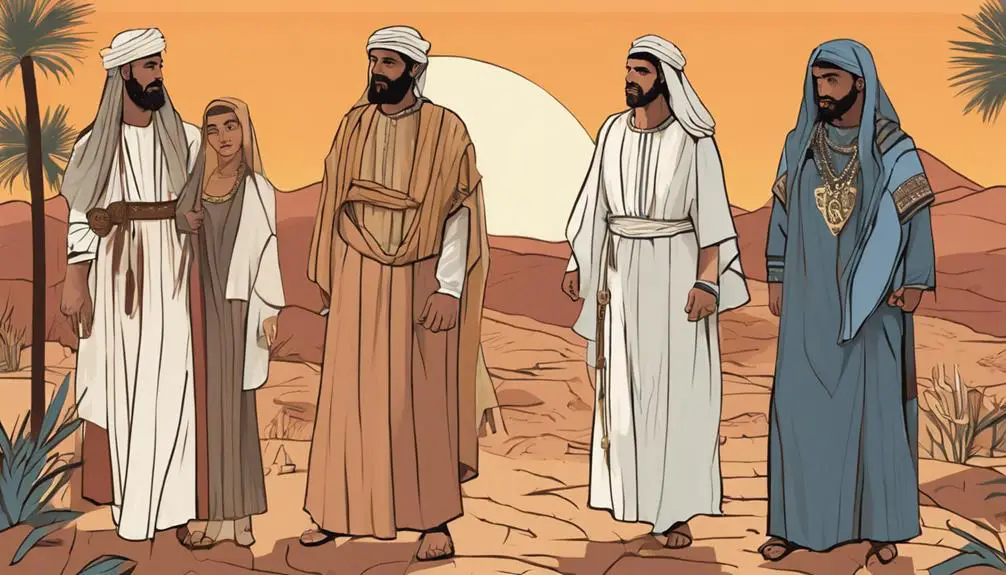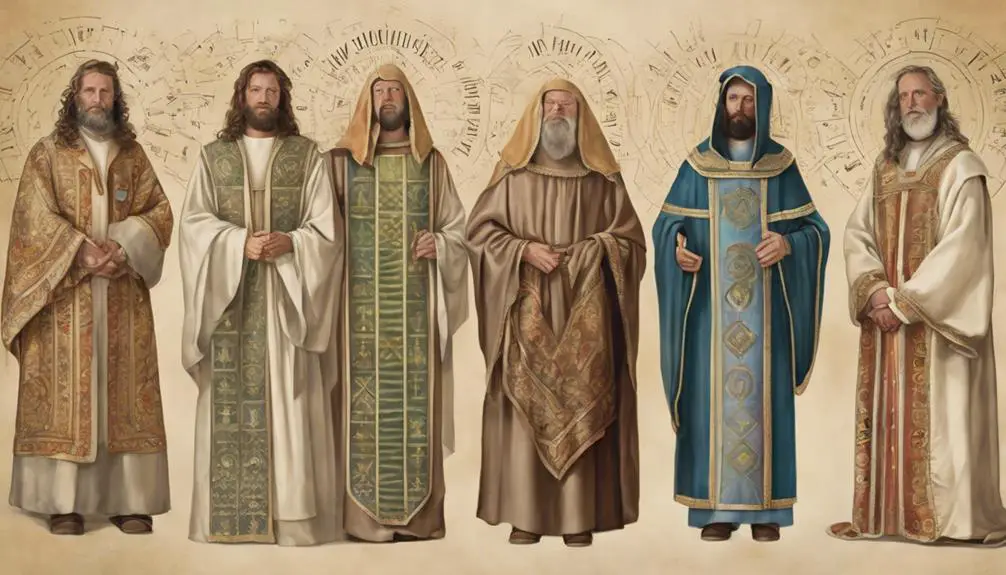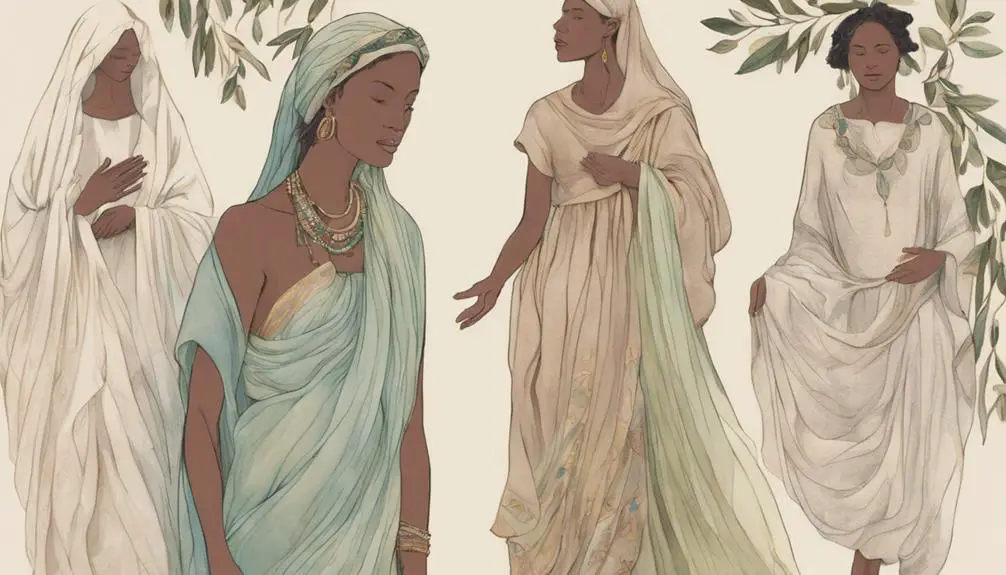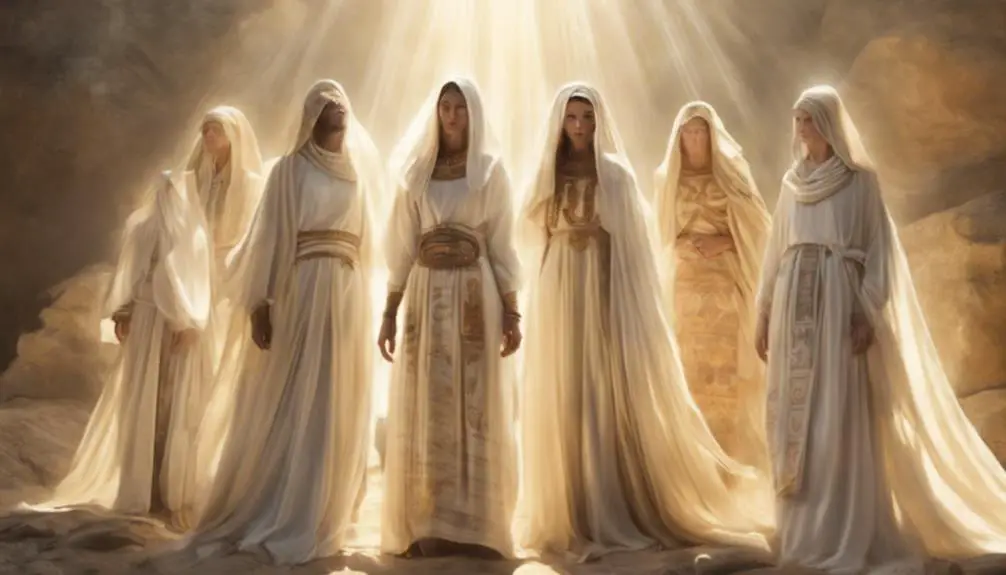Journey through biblical texts to unravel the rich symbolism of raiment, discovering layers of meaning in the threads of faith.

Raiment in the Bible
Reflecting on raiment reveals rich revelations throughout the Bible. You'll find that clothing isn't merely about modesty or fashion; it's imbued with profound symbolism and identity.
From divine directives on dress to the profound significance of prophetic and priestly garments, each thread weaves a narrative that transcends time.
As you explore these sacred scriptures, you'll unearth how clothing miracles and messages shaped the lives of those within and beyond the biblical text.
The question then becomes, what deeper meanings might lie in the fabrics of faith, waiting for you to uncover?
Key Takeaways
- Raiment in the Bible symbolizes identity, status, and divine favor, deeply intertwined with societal norms and values.
- Divine instructions on clothing highlight moral and spiritual purity, and differentiate roles within biblical narratives.
- Prophetic and priestly garments signify divine authority and sanctity, with materials and care underscoring holiness.
- Clothing miracles and messages in scriptures reveal God's power and communicate His will, indicating spiritual transformations.
Symbolism of Raiment

In the biblical narrative, raiment frequently serves as a potent symbol, embodying themes of identity, status, and divine favor. Your examination of these garments reveals a rich tapestry of cultural interpretations and the evolution of fashion within these ancient texts. As you delve deeper, it becomes apparent that the clothing described isn't merely functional; it's imbued with significant meaning, shaped by the societal norms and values of the time.
The evolution of fashion, as chronicled in these scriptures, reflects not just changes in aesthetic preferences but also shifts in cultural attitudes towards spirituality, morality, and social hierarchy. For instance, the transition from simple tunics to more elaborate garments often coincides with periods of prosperity and divine blessing, suggesting a link between one's outward appearance and their perceived favor in the eyes of the divine.
Moreover, the cultural interpretations of these garments underscore how deeply clothing is intertwined with expressions of power, purity, and prophecy. Each thread, color, and fabric choice is a deliberate decision, echoing the prevailing beliefs and practices of the time. You're invited to consider how these ancient perspectives on raiment might mirror or diverge from contemporary views on fashion and symbolism, providing a unique lens through which to view the past.
Raiment and Identity
CURRENT SUBTOPIC: 'Raiment and Identity'
Clothing, throughout biblical narratives, often acts as a defining marker of individual and communal identity, reflecting both personal choice and divine mandate. You'll find that garments are not merely functional but carry significant weight in signaling status, profession, and even moral standing. These sartorial choices serve as cultural expressions, evolving with the times yet deeply rooted in ancient traditions.
Consider the priests' vestments, meticulously described for their sacred duties, versus the simplicity of a prophet's cloak. These distinctions aren't accidental but deliberate, weaving a rich tapestry of fashion evolution within a spiritual context.
Garment |
Significance |
|---|---|
Priestly Vestments |
Divine service, holiness |
Prophet's Cloak |
Simplicity, divine message |
Royal Robes |
Authority, leadership |
Widow's Attire |
Mourning, societal role |
This table illustrates how clothing functions beyond mere adornment. It's a language, a form of non-verbal communication that speaks volumes about the wearer's role, societal expectations, and even divine favor or disfavor.
As you delve deeper into these narratives, you'll notice how seamlessly fashion and faith intertwine, offering a glimpse into the complex interplay between divine prescriptions and human expressions of identity.
Divine Instructions on Apparel

Scripture reveals that divine commands concerning apparel serve not only to distinguish roles within the community but also to reflect broader theological principles guiding human conduct. These directives, encompassing fabric regulations and modesty mandates, underscore a theological ethos prioritizing purity, distinction, and respect for the divine order.
Fabric regulations, for instance, aren't mere arbitrary preferences but symbolize moral and spiritual purity. The prohibition against mixing certain types of fabric serves as a metaphor for the separation from impurity and idolatry, reinforcing the call to holiness among the faithful. This principle extends beyond mere physical attire to embody a holistic approach to purity in one's life and actions.
Similarly, modesty mandates aren't solely about personal decorum but signify a deeper theological stance. They advocate for a humble and respectful presentation of oneself, reflecting an awareness of one's place within the sacred community and before God. Modesty in apparel becomes a manifestation of an inward modesty of spirit, a submission to divine will, and a respect for the communal ethos.
These divine instructions on apparel thus serve as tangible expressions of deeper spiritual truths, guiding individuals to live in a manner that reflects their sacred identity and mission within the broader theological narrative.
Prophetic and Priestly Garments
Building on the understanding that divine instructions on apparel symbolize deeper spiritual truths, we'll now examine the significance of prophetic and priestly garments within this sacred context. The Bible meticulously details these garments, emphasizing not just their aesthetic appeal but their profound spiritual implications. Prophetic and priestly attire served as visual sermons, embodying divine authority, sanctity, and the intermediary role between God and His people.
- Symbolism and Design: Each garment, with its specific fabric materials and colors, was laden with symbolic meaning, pointing to theological truths and the character of God.
- Fabric Materials: The choice of linen, wool, and other materials for these garments underscored purity, holiness, and divine selection, setting the wearer apart for sacred duties.
- Garment Preservation: The meticulous care and preservation of these garments underscore their lasting significance and the ongoing legacy of the priesthood and prophecy in biblical history.
- Spiritual Identity: Through their unique designs, these garments marked the wearer as occupying a special role, directly appointed and anointed by God for service.
Analyzing these garments reveals a deeper understanding of God's intentions for leadership, worship, and community within the biblical narrative, emphasizing the interwoven nature of physical attire and spiritual realities.
Clothing Miracles and Messages

Throughout biblical narratives, clothing often serves as a medium for miraculous events and profound messages, reflecting the divine's interaction with humanity. You'll find that garments aren't mere coverings but conduits of God's power and communicators of His will.
Fashion transformations in the scripture aren't just about physical changes but signify deeper, spiritual renewals and revelations. For instance, when Joseph's coat of many colors is torn and stained with blood, it's not merely an act of violence but a pivotal moment that sets in motion a divine plan extending beyond human comprehension.
Similarly, attire interpretations play a crucial role in understanding God's messages. The seamless tunic of Jesus, for example, symbolizes unity and perfection, underscoring the seamless nature of His teachings and the unbreakable bond with His followers. These narrative elements invite you to delve deeper into the symbolic layers of biblical stories, revealing that every thread woven into the fabric of these tales carries weight and meaning.
Frequently Asked Questions
How Did Climate and Geography Influence the Materials and Styles of Raiment Mentioned in the Bible?
In analyzing how climate and geography influenced clothing materials and styles, you'll find the local environment dictated animal usage for fabrics. Hot, arid regions meant lighter, breathable materials were essential, leading to innovations in fabric preservation to extend garment life.
The availability of animals, like sheep for wool, played a crucial role. This interaction between geography, climate, and resources shaped the distinct styles and materials you see, emphasizing practicality and adaptability.
What Role Did Economic Status Play in the Variety of Raiments Worn by Different Classes in Biblical Times?
In ancient societies, economic status significantly influenced your wardrobe. A staggering 90% of wealth could dictate garment variety. This disparity highlighted gender distinctions and ceremonial uses, especially in religious contexts. Affluence allowed for diverse fabrics and intricate designs, marking social standing and roles.
Conversely, the less fortunate donned simpler attire, lacking such distinctions. Analyzing this through a scholarly lens, one sees a clear correlation between economic status and the complexity of garments, reflecting societal structures and values.
Were There Specific Colors of Clothing That Were Popular or Had Special Meanings Outside of Religious Symbolism?
In ancient times, clothing colors carried deep symbolism, influenced by limited dye sources. You'd find that color symbolism reflected societal values and statuses.
For instance, purple, sourced from rare sea snails, symbolized wealth and power, as only the elite could afford it. Similarly, red, derived from expensive minerals or insects, denoted status and bravery.
These colors transcended mere aesthetics, embedding themselves into the fabric of society, revealing much about historical social structures and beliefs.
How Did the Process of Making Clothing (Weaving, Dyeing, Sewing) Differ in Biblical Times Compared to Modern Methods?
You might find it fascinating that 90% of modern clothing is mass-produced, a stark contrast to ancient practices.
Back then, weaving techniques were manual, relying on looms that required skillful hands. Dye sources were natural, derived from plants and minerals, making each piece unique.
The process was labor-intensive, with every step from spinning yarn to sewing garments done by hand, reflecting a deep connection to craftsmanship lost in today's fast fashion.
Are There Any Documented Changes in Biblical Raiment Styles Over the Centuries Due to External Cultural Influences?
Yes, you'll find that raiment styles evolved significantly over centuries, notably influenced by external cultural exchanges. These shifts are especially visible in ceremonial practices and military uniforms, reflecting the adoption of foreign elements.
This evolution wasn't just about fashion but also indicated deeper societal and cultural integrations. Such changes underscore how external influences reshaped traditional attire, blending local traditions with innovations brought by trade, conquest, and intercultural interactions.
Conclusion
So there you have it, a whirlwind tour of biblical fashion statements. From divine dress codes to prophetic pantaloons, the Good Book's got more wardrobe changes than a Broadway show.
It's clear that in the scriptures, what you wear isn't just about covering up; it's a divine directive, a marker of identity, and sometimes, a miraculous message.
So next time you're picking out your Sunday best, remember, you're participating in a tradition as old as Eden itself. Who knew holy writ was so haute couture?



Sign up